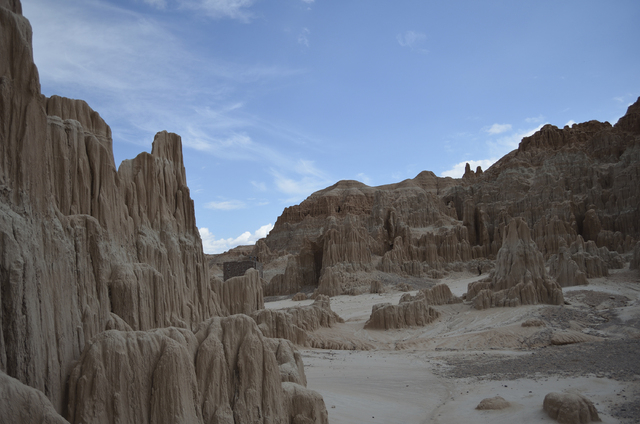Fall a fine time to visit scenic Lincoln County

Rural Lincoln County offers beautiful scenery and varied recreation year-round within easy reach of Las Vegas.
This sparsely populated region comprises old towns, ancient rock art, numerous all-terrain vehicle trails and five outstanding areas preserved as state parks. Visit Lincoln County this autumn and you’ll enjoy seasonal color until the snow flies.
To reach Lincoln County, head north from Las Vegas on Interstate 15, exiting onto U.S. Highway 93 near Apex. As it heads toward the ranching community of Alamo, U.S. 93 skirts the Pahranagat Lakes, a national wildlife refuge for waterfowl and shore birds. At this time of year, the quiet waters reflect the golden foliage of cottonwood trees near the shoreline. A common roadside shrub, the humble rabbitbrush turns deep gold in the fall, putting on a spectacular show along area highways.
The road drops from a small summit into a narrow valley at the old railroad town of Caliente. Part of the Meadow Valley Wash drainage that feeds into the Muddy River and then into the Virgin River, this well-watered area fosters fields, pastures, orchards, stands of cottonwoods and willows that color up in the fall.
Set in a box canyon with 700-foot cliffs, Kershaw-Ryan State Park is the site of a former ranch about two miles south of Caliente, just off U.S. 93 on state Route 317. It attracts picnickers, campers, hikers, wildlife watchers and group outings. Kershaw-Ryan has a great deal to offer, despite being the smallest of Nevada’s 23 state parks, historical sites and recreation areas. It includes a spring-fed pool and a children’s playground. Its 15-unit campground contains restrooms with showers and an RV dump station. The park will host a Nevada Day/Halloween event called Pumpkins in the Park on Oct. 24, complete with games and a haunted hike.
The fall color should remain vibrant in this protected canyon through Thanksgiving. Like the other state parks in Lincoln County, Kershaw-Ryan remains open all year, but it often sees very cold temperatures and snow in winter. At all the parks, entrance fees are $7, discounted $2 for Nevada residents. Camping fees are $17 per night at four of Lincoln County’s state parks. All campsites are available on a first-come basis.
Continue north on U.S. 93 from Caliente to reach the other parks in Lincoln County. The most remote park in the area is Beaver Dam State Park, located near the Nevada-Utah border. It can be reached by driving about 28 miles on an unpaved road from a turnoff on U.S. 93 about six miles north of Caliente. This park contains trout streams that feed into the Virgin River through Beaver Dam Wash near Littlefield, Ariz.
Beaver Dam was one of Nevada’s first four state parks created in 1935. The little valley with streamside trees surrounded by forests offers bright foliage in fall. Because of its steep terrain, the area is prone to flash floods. It once had a dam and a reservoir, which were badly damaged in 2009, and has been restored to its pre-dam state. Visitors today find picnic areas, two campgrounds with water available from April through November, hiking trails and fishing. Camping costs $14 per night.
Located south of Pioche just off U.S. 93, Cathedral Gorge is another of the original four state parks, preserved for its unusual geology of eroded canyons and formations. Stop by the regional visitor center near the park entrance for information on all area parks. Cathedral Gorge offers picnic areas, five hiking trails and two campgrounds with hookups for a $10 fee. Autumn color will show up along roadsides and near campsites shaded by trees.
East of Pioche, Echo Canyon and Spring Valley state parks feature reservoirs with fishing, boating and wildlife watching. Echo Canyon is 12 miles from Pioche using state routes 322 and 323. It offers picnicking, 33 campsites and hiking. Spring Valley is 20 miles from Pioche on state Route 322 in an area of pioneer ranches. The park has a 37-site camping area with water, toilets and showers, as well as seven primitive campsites. Autumn color shows up in these parks along roadsides, in wetlands and on nearby ranches in fields, pastures, orchards and shade trees.
Margo Bartlett Pesek’s column appears on Sundays.